British Expansion in India – Mysore, Maratha
British Expansion in India
The political situation in Deccan
In the 1760s, the neighbouring states in the Deccan came into conflict with each other in their attempt to expand their territories to fulfil their need for resources. Three factors pushed this conflict:
- Maratha’s Loss in 1761 made them weaker and a target for the neighbouring Hyderabad.
- The rise of Mysore threatened its neighbouring states, and the Marathas and the Nizam formed an alliance against Mysore and also cooperated with the British to curb the power of Mysore.
- Nizam was equally apprehensive of the Maratha’s expansion in the south and therefore cooperated with the British against the Marathas.
British Expansion in Mysore
The Mysore Kingdom was founded by Wodeyars, who were vassals of the Vijayanagar Empire. Chikka Krishnaraja Wodeyar II ruled Mysore from 1734 to 1766.
Haider Ali, a captain in the Kingdom’s army, rose to prominence, eventually becoming the de facto ruler. He and later his son, Tipu Sultan, were involved in a constant struggle with the British.
Reasons for Anglo-Mysore rivalry:
- The British saw Haider Ali’s and Tipu Sultan’s control over Malabar as a threat to their commercial interests.
- Mysore was also seen as a threat to British control over Madras.
- The French alliance with the Mysore rulers was seen as a threat to British dominance in this region.
The First Anglo-Mysore War (1767-69)
The British signed a treaty with the Nizam of Hyderabad in 1766, in which Nizam ceded to them the Northern Circars and in turn British would provide protection against Hyder Ali.
- The Nizam and the Marathas entered into a pact with the British against Haider Ali, and the Marathas attacked Mysore in 1766.
- However, Hyder Ali showed his diplomatic skills and paid the Marathas to become neutral and converted the Nizam into his ally (against the Nawab of Arcot).
- Haider Ali then launched an attack against the British and reached up to the gates of Madras.
- The British had to conclude a humiliating treaty with Haider Ali in 1769, the Treaty of Madras.
- Both powers agreed to help each other in case of an attack by a third party.
British Expansion in Marathas
After their defeat in the third battle of Panipat, Maratha’s power revived in the early 1770s under Madhavrao Scindhia and asserted its power on Mysore and Nizam of Hyderabad.
British Expansion in India under Warren Hastings (1772-85)
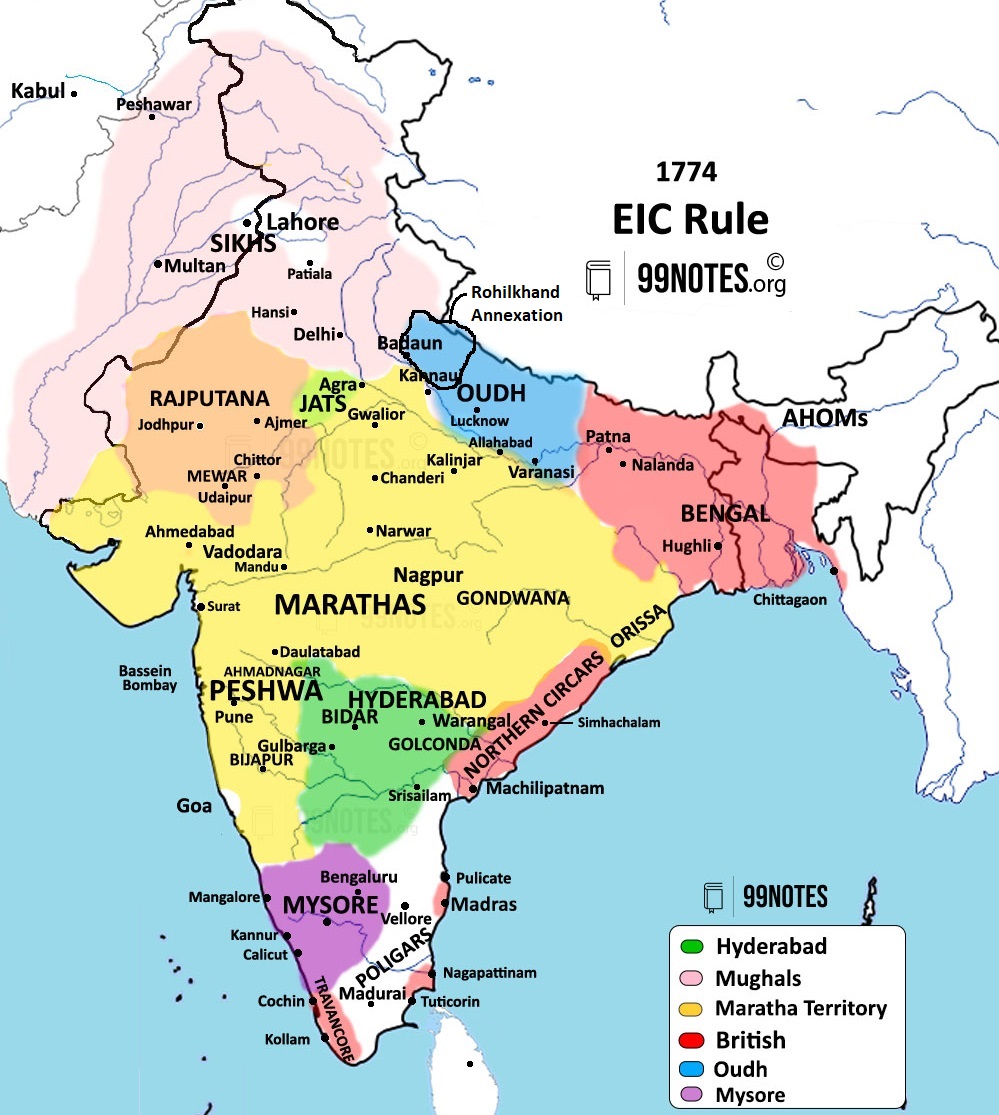
Policy of Ring-Fence
Warren Hastings upon his takeover, started a ring-fence policy that involved the creation of buffer states around their territories to avoid direct confrontation with powers like the Marathas and Afghans. Terms of the Policy dictated that:
- The East India Company would take responsibility for its ally’s security, and the ally, would take care of the expenses.
- This way, the local ruler would become dependent on the British and lose their freedom in diplomatic and defence issues.
In 1774, Warren Hasting assisted the Nawab of Oudh in the Rohilla war, which led to the annexation of Rohilkhand into Oudh. Hastings justified his action on the ground that Oudh, was needed as a strong buffer state to defend the British interests.
The policy of Ring-Fence was further developed into the subsidiary alliance by Lord Wellesley.
The First Anglo-Maratha War (1775-82)
In 1773, Narayan Rao, the strong Maratha Peshwa was assassinated. In his place, Nana Phadnavis, a powerful Maratha minister, wanted to name Narayan Rao’s infant son, Sawai Madhavrao, as the next Peshwa.
- However, Raghunath Rao, the uncle of Narayan Rao, who had usurped the position of Peshwa, was unwilling to give up his position and sought help from the British.
- Raghunatha Rao promised to cede Bassein and Salsette to the British under the Treaty of Surat (1775, with Bombay council) in lieu of British help to regain his position. Warren Hastings annulled this treaty as he did not want to confront the Marathas.
- The Treaty of Purandhar (1776) was signed between the Calcutta council and Nana Phadnavis, in which Sawai Madhavrao was recognised as Peshwa.
- However, the Bombay Council violated the treaty by giving refuge to Raghunath Rao.
The Executive council |
| Here, it must be noted that each presidency had an executive council under the Regulating Act of 1773. Earlier, all three presidencies acted independently. However, after the 1773 act, the Governor of Bengal became the Governor General of Bengal, under whom the Governors of Madras and Bombay were formally placed. |
Course of the war
- In 1777, Nana Phadnavis violated the Purandhar treaty by granting the French a port on the west coast. The English retaliated by sending a force to Pune; however, the Marathas under Mahadji Scindhia forced the British to surrender.
- In 1779, The treaty of Wadgaon was signed in which the Bombay government had to relinquish all the territories they had acquired since 1775.
- Warren Hastings rejected the treaty and sent a large force. Finally, in 1781, Sindhia was defeated.
- The Treaty of Salbai was signed in 1782 between the Peshwa and Warren Hastings, which guaranteed peace for twenty years for the two sides.
- Salsette continued with the British and territories conquered since the treaty of Purandhar, 1776, including Bassein restored to the Marathas.
- The British would not offer any support to Raghunath Rao, and Peshwas would grant him a maintenance allowance.
- Peshwas would not support any other European power.
The Second Anglo-Mysore war (1780-84)
While the British conflict with the Marathas was hot, Mysore tried to secure an alliance against the British. Two factors aided this:
- British proved to be unreliable partners: The British violated the Madras treaty by not coming to Haider Ali’s aid when the Marathas attacked in 1771.
- French Help: The outbreak of hostilities between French and British due to the American War of Independence (1775-83). British tried to capture Mahe, a French settlement within Haider’s territories.
Thus, Haider Ali made an anti-British alliance with the Marathas and the Nizam.
Course of the war
- The British neutralised Haider Ali by winning over the Marathas and the Nizam to their side and defeated Haider Ali at Porto Novo in 1781.
- However, occasional skirmishes continued between both sides.
- In 1782, Haider Ali died of cancer. Now, his son, Tipu Sultan, continued the struggle.
- Fed up with inconclusive war, both sides opted for peace and signed a treaty of Mangalore in 1784, under which the status quo before the war was restored.
Under Warren Hastings, territorial expansion did not happen. His main focus remained to consolidate the British holdings. However, this changed under Cornwallis and Wellesley.
British Expansion in India under Lord Cornwallis (1786-93)
The third Anglo-Mysore war (1790-92)
The immediate cause of the war was Tipu’s declaration of war against the state of Travancore, an ally of the British.
Course of the war
- Initially, Tipu defeated the British in 1790.
- In 1791, Lord Cornwallis, with the support of the Marathas and the Nizam, defeated Tipu at Seringpattam.
- In 1792, under the treaty of Seringpatam, Tipu had to give up nearly half of Mysorean territory to the British, the Marathas and the Nizam. In addition, he had to pay a war indemnity of three crores, for which the British took Tipu’s two sons hostage.
British Expansion in India under Lord Wellesley (1798-1805)
Wellesley was an expansionist. He followed a three-pronged strategy:
- Taking control of already ‘protectorate states’: For example, in Tanjore, Surat and Carnatic, the British took over administration by paying pensions to the rulers and letting them retain their titles.
- Subsidiary alliance to bring new states under influence.
- Outright war against those still defiant. The 4th Mysore War (1799) and the 2nd Maratha War (1803-05) can be called a part of this strategy. These two wars decided the fate of the Indian subcontinent for the next 150 years.
The policy of Subsidiary alliance
The origin of the subsidiary alliance is found in French Governor Dupleix, who used to lend European troops to the Indian states. However, it was adopted at a large scale by lord Wellesley. One of the objectives of this policy was to keep the French from reviving and expanding their influence in India.
Key Points of policy of Subsidiary alliance
- The allying state was forced to accept the permanent stationing of a British force within his territory.
- A British resident was posted in the state’s court.
- The state could not go to war or negotiate with any other Indian ruler without the concurrence of the Governor General.
- The Indian ruler could not employ any European without consulting with the Company.
- In return, the British would defend the rulers from any incoming attack and adopt a policy of non-interference in internal matters.
Impact of policy of Subsidiary alliance
- The Indian states lost their independence on security and foreign policy matters.
- They lost a significant amount of revenue in the maintenance of the British troops.
- The rulers became weak and irresponsible, and it was almost impossible to depose them even if they exploited their subjects.
- In 1798, The Nizam of Hyderabad became the first victim of this policy. Later, the state of Mysore in 1799 and Oudh in 1801 also came under the subsidiary alliance.
The fourth Mysore war (1799)
In 1796, when the Hindu ruler of the Wodeyar dynasty died, Tipu refused to place the minor son of Wodeyar on the throne and declared himself the Sultan. Upon accession, he worked to avenge his last defeat and the humiliating treaty of Seringapatam.
Alliance with French: Tipu was reaching out to Napoleon for help, and even a Jacobian Club was started, and the French flag was hoisted. Concerned by Tipu’s growing friendship with the French, Wellesley tried to force him to submit to a subsidiary alliance.
Course of the war
- The British got the help of the Marathas, who were promised half of the Tipu’s territory, and Nizam was already in a subsidiary alliance.
- Tipu was defeated in a brief but fierce war. Arthur Wellesley, brother of Lord Wellesley, also participated in the war.
- The British restored the Kingdom to the Wodeyars into the subsidiary alliance system.
Wodeyars under Subsidiary Alliance |
|
The second Anglo-Maratha war
In 1795, Peshwa Madhavrao Natrayan committed suicide. After Peshwa Madhavrao Narayan committed suicide in 1795, Bajirao II, son of Raghunath Rao, became the Peshwa. In 1800, Nana Phadnavis, who provided leadership to the Marathas, died. The prevailing situation allowed the British to intervene in the Maratha affairs.
Course of the war
- In 1801, the Peshwa brutally murdered the brother of Jaswantrao Holkar, Vithuji.
- The furious Jasawantrao Holkar defeated the combined army of Bajirao II and Scindhia and placed Vinayakrao, son of Amritrao, on the Peshwa seat.
- Bajirao II fled to Bassein and signed the treaty of Bassein with the British.
Treaty of Bassein (1802)
- The Peshwa agreed to the subsidiary alliance with the British.
- To surrender the city of Surat along with other territories yielding an income of Rs.26 lakhs.
- To surrender all claims of Chauth on Nizam’s territories.
After this humiliating treaty, Daulat Rao Scindhia and Raghoji Bhonsle united their forces in an attempt to save the Maratha independence but were defeated by the British under the leadership of Arthur Wellesley. Again, in 1804, Yaswantrao Holkar tried to form a coalition of Indian rulers but failed.
Significance of the Bassein treaty
- The permanent presence of British troops gave the British a great strategic benefit. Now the Company’s troops were evenly spread throughout the region and could be rushed to any place without much delay.
- The treaty cleared the way for a more dominant British presence in India, destroying their strongest adversary, the Marathas.
Expansion under Lord Hastings (1813-23)
Third Anglo-Maratha war
Causes for the 3rd Anglo-Maratha War:
- Feeling of Revenge: The treaty of Bassein had significantly damaged the pride of the Marathas, who now wanted to avenge their previous defeats.
- Action against Pindharis: Pindaris were mercenaries who became unemployed when local armies were disbanded after the emergence of the Subsidiary alliance. The bands of Pindharies started plundering the Company’s territories. Lord Hasting acted against them, and his forces even entered Maratha territories following these bands. This was a transgression on the Maratha sovereignty.
In 1817, Bajirao II made a last bid to rally together the Maratha chiefs against the British, and war started.
Course of the war
- The Maratha chiefs attacked their respective British residencies; however, all of them were defeated.
- The battle of Bhima Koregaon was fought in 1818, with Peshwa and the king of Satara on one side and the British along with Mahar soldiers on the other.
- Finally, the Peshwa surrendered and pensioned off to Bithur near Kanpur and the Peshwaship was abolished, and the Maratha confederacy was dissolved.
Causes of Maratha’s defeat
- Mutual bitterness & lack of cooperation amongst themselves: Marathas never united together to face the British until the 3rd Anglo-Maratha War when their power had practically waned.
- Lack of capable leadership: Peshwas and Sardars were selfish leaders who could never see a grander picture. After the Death of Nana Phadnis, Marathas did not produce any good military strategists.
- Weak Military Strategies of Marathas
- Poor governance in conquered territories, where Marathas were often seen as looters.
- Taxation policy: Stressed relationships with other princes or Nawabs due to taxation of Chauth and Sardeshmukhi.
- They failed to estimate the political & diplomatic strength of the British.
Evolution of British expansionist policy
Warren Hastings
- During Hasting’s tenure, the British expanse was in the nascent stage; hence, his focus was to defend the existing territories.
- He had to deal with the joint front of the Marathas, Mysore and the French.
- After the entry of France into the American Revolution in 1778, he was also confronted with French expeditionary forces in the Indian Ocean.
- He conceived the Ring-Fence policy to defend the Company’s territory from the Marathas and the Afghans.
- Warren Hastings is credited for undertaking civil administration reforms and expanding the British Dominion and is considered the architect of British India.
Lord Wellesley
- He was an outright imperialist who did not hesitate to wage wars to expand the Company’s territory.
- He adopted a three-pronged expansion strategy:
-
- Taking control of protectorate states such as Surat, Carnatic, Tanjore etc.
- Forcing the Indian states into the system of the Subsidiary alliance.
- An outright war against those who defied, for example, Mysore.
- Under his tenure, Tipu Sultan was defeated, and the Marathas had to sign the humiliating treaty of Bassein.

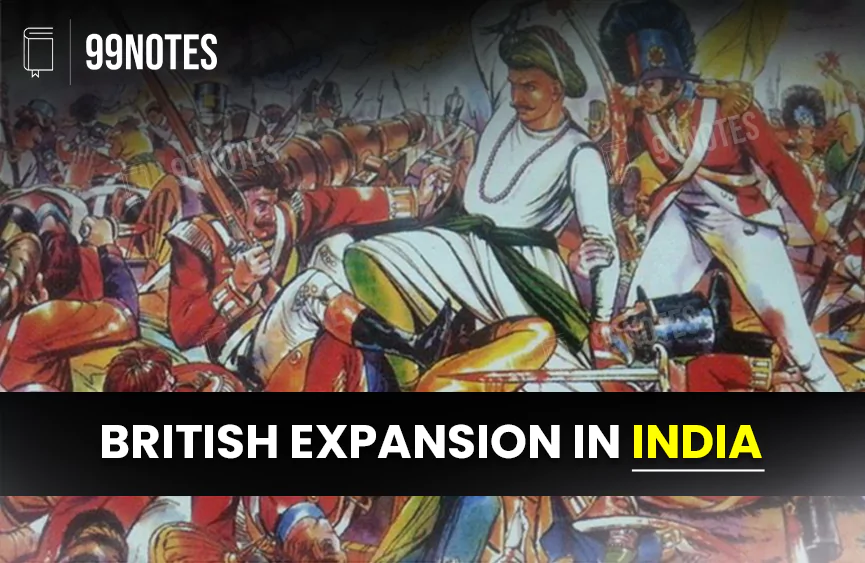


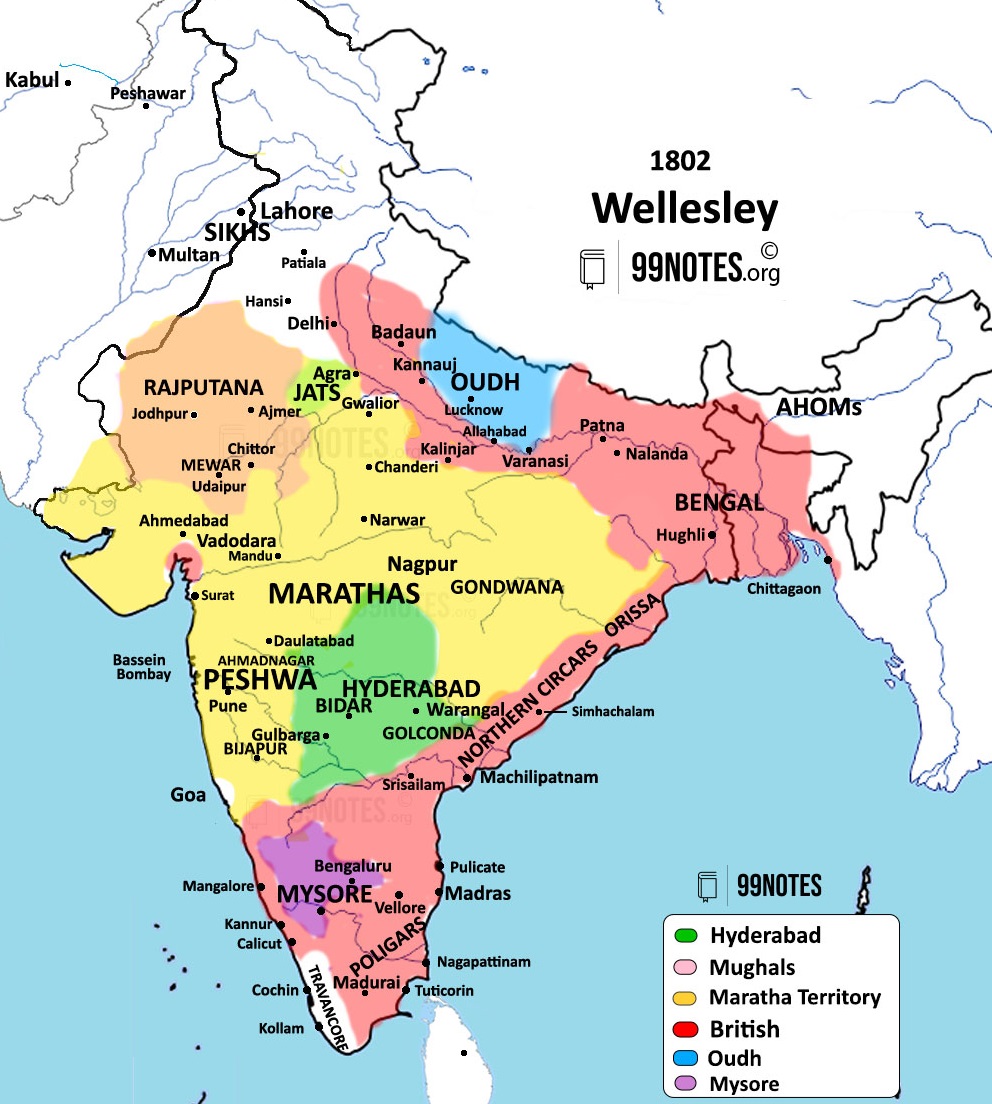


![Post Mauryan Period: Shunga, Kanva Dynasties &Amp; More [Upsc Notes] | Updated July 27, 2024 Post Mauryan Period: Shunga, Kanva Dynasties & More [Upsc Notes]](https://99notes.in/wp-content/uploads/2023/04/post-mauryan-age-99notes-upsc-1-768x495.webp)


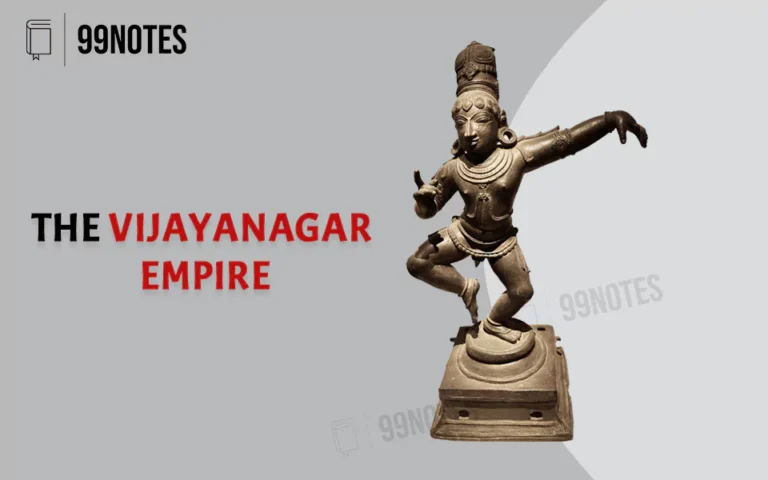
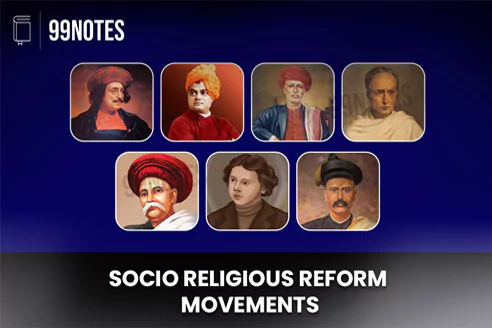
![Early Political Activities: 1858-1905 [Complete Notes For Upsc] | Updated July 27, 2024 Early Political Activities: 1858-1905 [Complete Notes For Upsc]](https://99notes.in/wp-content/uploads/2024/02/early-politics-featured-66698a6014484-768x500.webp)